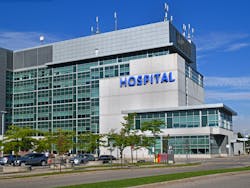As we reported on Monday, the press release posted to the firm’s website on Monday highlighted all the bad news. Most glaringly, there were these marquee-level statistics: “The median Kaufman Hall hospital Operating Margin Index was –0.6 percent in January, not including federal Coronavirus Aid, Relief, and Economic Security (CARES) Act funding. With the funding, it was –0.1 percent. The median Operating Earnings Before Interest, Taxes, Depreciation, and Amortization (EBITDA) Margin was 4.0 percent without CARES and 4.8 percent with CARES. Not including the federal aid, Operating Margin fell 46.1 percent (4.6 percentage points) and Operating EBITDA Margin was down 34.1 percent (4.2 percentage points) compared to January 2020.
Those statistics are just dreadful, honestly. As Jim Blake, a KaufmanHall managing director and the publisher of the National Flash Report, put it in a statement contained in the press release, “January marked a potential turning point in the pandemic, as we saw federal coronavirus statistics start to wane later in the month. While declining COVID-19 cases and hospitalizations are a very welcome sign, the pandemic continues to create a challenging situation for hospitals and health systems. We must remain vigilant in our fight against the virus, and in providing these vital institutions the support they need to move toward recovery.”
And the numbers below the marquee numbers are no better; in fact, some are downright ominous, to wit: “Volumes fell year-over-year across most metrics as many healthcare consumers continued to avoid or delay care. Year-over-year, Adjusted Discharges fell 17.6 percent, Adjusted Patient Days declined 8.3 percent, and Operating Room Minutes fell 16.6 percent.”
Even more worrisome, “Outpatient Revenue fell below prior year levels for the ninth time in the past 10 months, down 10.4 percent compared to January 2020. The lower outpatient revenues pushed Gross Operating Revenue (not including CARES) down 4.8% year-over-year, while total Inpatient Revenue increased just 1.3 percent year-over-year.” And yet expenses have been rising, because of the high costs of caring for COVID-19 patients, in terms of labor, drugs, personal protective equipment (PPE), and other equipment and supplies.
Nearly all of this is readily explainable, yet that doesn’t make any of it easier for senior hospital and health system leaders. First of all, COVID-19 patients are generally extremely high-acuity patients, and are often spending several weeks in ICUs, appropriately receiving very intensive, staff-consuming care. So, relative to the reimbursement that hospitals are receiving while caring for COVID patients, their cost is quite high.
Meanwhile, as everyone knows, many healthcare consumers/patients are delaying medical care, sometimes even highly needed care, out of fear of infection, as the pandemic grinds on. That, too is absolutely understandable. But what’s clearly happening is that patients are avoiding or postponing care of the type that leads to reimbursement that is desperately needed right now to stabilize hospitals’ finances.
Unfortunately, there’s no easy or simple solution to any of this. For one thing, we as a nation face at least several more months this year of large COVID-19 patient censuses (even as hospitalization rates finally began to decline this month, after reaching terrible peaks nationwide last month). As the report notes, “Looking at adjusted expenses, Total Expense per Adjusted Discharge jumped 25.4 percent YOY, largely due to a 30.1 percent YOY increase in Labor Expense per Adjusted Discharge. Full-Time Equivalents (FTEs) per Adjusted Occupied Bed (AOB) rose 6.1%. Non-Labor Expense per Adjusted Discharge rose 24.4 percent YOY, with the most significant increases occurring in Purchased Service Expense per Adjusted Discharge at 37 percent YOY and Drug Expense per Adjusted Discharge at 36% YOY. Overall Supply Expense was down just 1.5 percent YOY in January, but rose 19.9 percent YOY once adjusted to the month’s volumes.”
What’s more, the report noted, “ In the broader economy, inflation and jobs data fell below expectations in January, as growth slowed considerably through the winter months. Stock values slid as trading driven by social media drew broad media attention, pushing the S&P 500 down 1.1% in January. The Federal Open Market Committee held steady at its January meeting and made no major changes its guidance, keeping accommodative interest rates and asset purchase policies unchanged.”
Ultimately, the report concluded that, “While national CDC metrics show some signs that the country may be turning the corner on the pandemic, its repercussions for the healthcare industry will persist indefinitely. The January performance results reflect the continued burden on U.S. hospitals and health systems, and emphasize the importance of remaining vigilant in combatting the virus and moving these vital institutions toward recovery.”
In other words, we as a nation will simply need to get through the pandemic and to the other side. There isn’t really any other way forward, apart from the possibility of the federal government—the Biden administration and the U.S. Congress—moving to further financially shore up hospital organizations right now—and that remains a relatively distant possibility, given all the other props that are going to have to be advanced inside our economy right now.
The good news here is that, unlike what’s actually happened in countries like Brazil, our nationwide healthcare system has not collapsed, either in terms of patient care delivery, or financially. But this will no doubt go down in history as one of the most stressful periods in modern times for our U.S. healthcare system. The weight of the COVID-19 pandemic remains great, and it will only be once a very large percentage of the population is successfully vaccinated, that we will truly be out of the woods in terms of the pandemic—along all dimensions.


